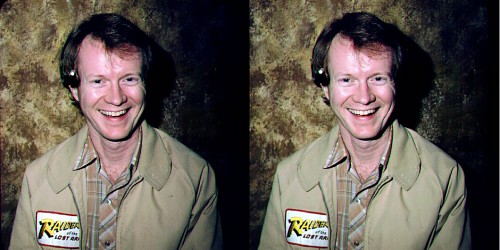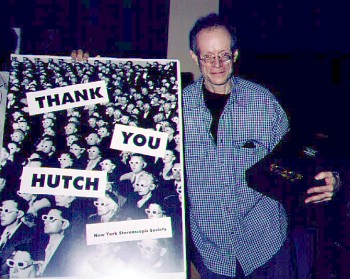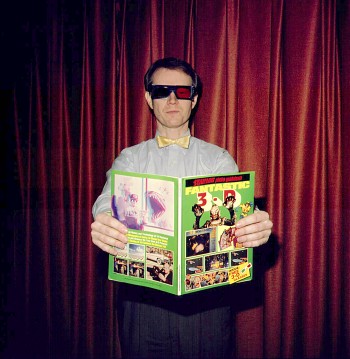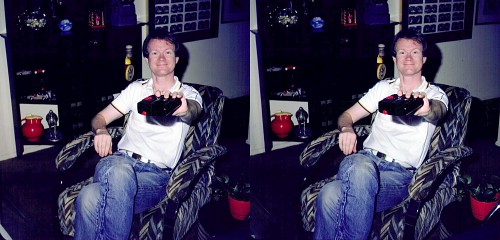DAVID HUTCHISON:
Oct. 18, 1946 - May 3, 2000
Some thoughts and remembrances by Susan Pinsky & David Starkman
with additional remembrances by a few of his friends

David Hutchison passed away on May 3, 2000. He died peacefully after a brave and difficult six month battle with pancreatic cancer. He was 53 years old. He was our dear friend for more than 20 years, and he was a friend to many in a wide variety of areas of interests.
David was a very private person. He had great intelligence, humor, enthusiasm and creativity. We mainly knew the 3-D facet of Hutch (as he was affectionately known to all of his friends) and we loved him for it. He also had a very strong appreciation and career in opera , a Tesla coil engineering interest, and an acting, directing and theater life, which we personally knew very little about. We met around 1979 when he came to California and visited us. We first met due to mutual crossover interests in science fiction and 3-D. David Starkman had been a "Starlog" magazine reader since it's first issue in 1977. Hutch was a Production Assistant at Starlog, but immediately became a writer, and then Science Editor for the magazine. (See more later in this article by the former Publisher of Starlog). Before we ever met Hutch we read his wonderful articles about 3-D Sci Fi movies in issues No. 4 and 5 of Starlog in 1977. We seem to recall that this prompted us to write him and send him copies of our own "Reel 3-D News". In those days Hutch frequently came to Hollywood to cover the sci-fi movie scene, and we first met when he came to California for one of those work visits. To us meeting the Science Editor of Starlog was a great honor, but we immediately found ourselves at ease with Hutch. We became friends from that first meeting and shared our passion for everything 3-D in every way we could. We'd meet with Hutch almost every time he had the opportunity to visit California, which seemed pretty often for a number of years. Reporting of new 3-D projects, films and 3-D opportunities was also our goal for "Reel 3-D News" and "Stereo World", so we were fortunate enough to share some 3-D experiences with him, such as the press premiere of "Captain EO" at Disneyland in 1986. Since he came to Los Angeles regularly, Hutch also joined The Stereo Club of Southern California as a full member. We think he actually timed many of his visits so he would be able to attend the club's monthly meeting. Hutch was a Founding member of the New York Stereoscopic Society. He helped start it years ago when a small group of New Yorkers would get together intermittently to share a PSA 3-D slide show, or judge a PSA Traveling Slide Exhibition or just enjoy 3-D together. Bit by bit it grew into an official, serious organization of people researching, sharing, teaching and shooting in 3-D. The New York Stereoscopic Society now meets quarterly at the American Museum of Natural History. On April 14, 2000, about 2 weeks before he died, the NYSS meeting included a special tribute to Hutch in recognition of his contributions to the Society. Many of his friends were able to attend, and he was, too. He was thin, weak and pale, but noticeably pleased as ever to be surrounded by 3-D enthusiasm. He was delighted by the velvet-lined boxed gold-plated polarized glasses that were presented to him as the Founder's Trophy along with a poster of the classic 3-D audience shot with a big "THANK YOU, HUTCH - THE NEW YORK STEREOSCOPIC SOCIETY" . President Greg Dinkins and the entire NYSS committee thanked Hutch for all his efforts and contributions over the years.

Dinkins wrote a memorial after Hutch passed away, in which he stated "David was a source of expert advice, unlimited connections and years of experience in all things 3D. His book Fantastic 3-D [copyright 1982] is a must read for any student of 3D in pop culture. He was a friend and mentor to many budding stereo photographers. His service on the board of the National Stereoscopic Association, his years of participation in the Stereoscopic Society of America folios, and his awards from photography clubs around the world will surely make a place for him in the 3D Pantheon. Besides all this, he had two other successful careers as an editor of Starlog magazine and as a member of the company of the Metropolitan Opera [and New York City Opera]. Most important, he was a thoughtful, decent and caring person who will be sorely missed."

He will be missed by many. Hutch and Pinsky were on the National Stereoscopic Assn. Board of Directors together and used to spend many a late evening at an NSA convention discussing the details and challenges of the nearly all volunteer organization. We often shared adjoining hotel rooms at the NSA conventions so we could all keep talking about 3-D into the wee hours.
Central Park in New York was one of his favorite subjects for 3-D photography. He shot glorious images of it in each of its seasons. His dramatic shimmering snow and ice laden trees of the park always left me breathless. Then we would see his gorgeous back-lit changing autumn colors of the park or spring flowers and miniature horses and be even more impressed. As if those beauties weren't varied enough, he also shot it in color infrared. That's where Susan learned to shoot infrared slides. Hutch gave her her first roll to try out. He also encouraged and motivated Susan to use proper duping film in making slide duplicates. After Hutch passed away his sister wrote "David was born in Newark, NJ, Oct. 18th, 1946. He moved to Florida in 1954 and completed all schooling there. David started at U of Fl and transferred to FSU. Then moved to New York. He was a radio jock at FSU. As a teen he enjoyed photography, drama, music ( many years of piano and clarinet), science and literature. Excelled in all. Did summer theater in St. Augustine before his many summers at Cherokee in 'Unto these Hills', where he played many roles and was sound director."

In an obituary written by former Starlog owner, editor and close friend Kerry O'Quinn, he said "David Hutchison joined the STARLOG team in late 1976, the year Norman [Jacobs] and I launched this magazine. Appropriately, his first writing for us was "Science Fiction Movies in 3-D," beginning a two-part feature that explored Hollywood's brief 1950s love affair with "thrills that almost touch you through the magic of 3-Dimension." Introducing the next issue (# 5) as Editor-in-Chief, I wrote: "Hutchison gives us a delightful tour through the history and techniques of 3-D visuals. It's a subject that he has always been fascinated with (that's obvious from his knowledge and understanding), but for the first time he is being paid to discuss it."
And for the next twenty-four years, Hutch (as we called him) was paid to give our readers and our staff many delightful tours that sprang from the knowledge of his mind and the power of his passions. He had arrived at our offices a struggling actor, needing any kind of work. We needed any kind of help in the mail room, but almost immediately we learned that the tall, lean, blond boy who was quietly and efficiently stuffing envelopes had a wealth of information on various topics. In STARLOG # 6 Hutch wrote "The Magical Techniques of Movie and TV Special Effects." This started a feature series that established STARLOG as the primary source of information on what would become one of our most popular subjects. In the next issue (the legendary Star Wars cover) he continued his special effects series by introducing readers to little-known facts about Robby the Robot, one of his favorite science fiction characters. Hutch's articles soon led to a library of STARLOG Photo Guidebooks on Special Effects, featuring behind-the-scenes photos, technical diagrams, and explanations that revealed the secrets of movie magic. He put a bright spotlight on Hollywood artists who had mostly been invisible, before Industrial Light and Magic turned wizards into stars. He got to know everyone in the field, and they welcomed him into their workshops, knowing that his journalistic interest was rooted in genuine understanding and appreciation. The books and articles on special effects that Hutch wrote for STARLOG inspired our readers, and every day we received mail wanting more. His books and articles inspired me too. I wanted to publish a magazine devoted entirely to filmmaking - the kind of publication I had needed when I was a kid making 8mm movies with high school friends in the backyard. Hutch was the perfect person to edit such a magazine. He huddled with Norman and me to create CINEMAGIC, a serious journal that taught the techniques of production and special effects to young, hopefulfilmmakers. For several wonderful years CINEMAGIC was a joyous adventure for Hutch and me. We were kids at play, sharing our toys with other youngsters. Oh, it was hard work, and we both put in long hours, but it was a labor of profound love. I could not have had a better playmate. His enthusiasm, intelligence, and meticulous devotion to accuracy and detail helped give our publications the reputation they stand on today. In addition to our professional relationship, Hutch and I were friends. We shared many personal interests, from classical music and theater to Ayn Rand's philosophy of Objectivism. We were both fans of widescreen movie formats, starting in the days of Cinerama, CinemaScope, and VistaVision right up to present day IMAX 3-D spectaculars. We formed strong opinions oneverything, and we enjoyed disagreeing as often as we enjoyed jumping up and down with glee when something thrilled us both. A few weeks ago I attended a meeting of the New York Stereoscopic Society, an organization Hutch had pushed into being years ago. Knowing of his cancer (he'd spent several days in the hospital earlier that week), people had traveled from all over the country in order to honor him that night. He was thanked by many involved in the art of 3-D photography for inspiration and encouragement, and he was recognized for his creative,award-winning work. A few days before he died, I spent the afternoon with Hutch, talking about his life. He told me how he had come to love opera, a branch of theater he had first seen as "silly, stuffy, and poorly performed - which it was then." But once he saw a high-quality production, he was captured. He spent the rest of his life working nights and weekends as a super in productions at New York's Metropolitan Opera and New York City Opera. Hutch also explained that CINEMAGIC was important to him because "the sheer drive of young filmmakers, coming up to my office to show me things they'd done in their basement, was a great privilege. Most of those guys are now working in the industry. That's why I stayed in New York - because here you're surrounded by driven people, doing the most exciting things. I'ddie of boredom anywhere else." Like 3-D, Disney animation, IMAX, special effects, and grand opera - New York has magic. Because Hutch savored all the magic of life, and because we shared so many passions, he was one of my favorite playmates. There was no one else like him. He was an individual of his own creation. The magic of Manhattan is noticeably less dazzling without David Hutchison, and for me life is noticeably less fun." -- Kerry O'Quinn Richard Twichell, a fellow member of the Stereoscopic Society of America's Beta slide folio group wrote, after he heard about Hutch's death, " I was just looking at one of his slides: A winter scene in Central Park; the snow is newfallen and damp and heavy, and the picture is of a lonely path leading off into a snow covered wood. He will be sorely missed by his many friends in our group." Hutch's dear friend of 36 years, Robert Hefley, summed up the essence of Hutch when he said "...he was alive right up until that last moment when he wasn't. He went to his editor's job at STARLOG magazine on Monday, I took him to the hospital on Tuesday, and he died at 1:00 AM almost immediately after telling the nurse who asked him how he felt that, considering the circumstances, he felt fine. He was a remarkable man, and I will miss him." Before he died Starkman & I took time off to visit him in NY. He enjoyed the lovely little details of every day life, Central Park, his friends and his opera music. He was kind and gentle, introspective and intelligent, and extremely generous of heart and spirit. He was multi-talented, involved and interested in many areas and realistic and pragmatic to the end. We will always remember him in the area of 3-D for his many contributions, his passion and knowledge, his friendship and his book, Fantastic 3-D, aptly named for what he really was. "Many people will walk in and out of your life. But only true friends will leave footprints in your heart." - Eleanor Roosevelt. Hutch left many footprints in many, many hearts. He will be deeply missed. | 


